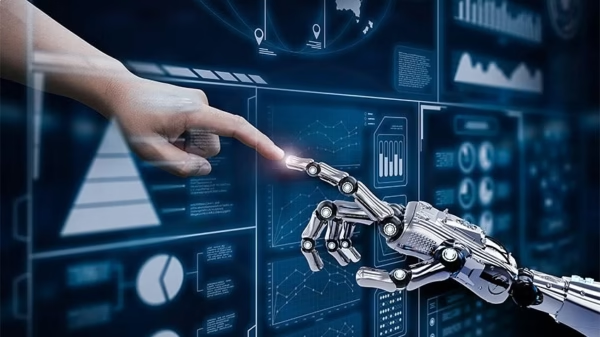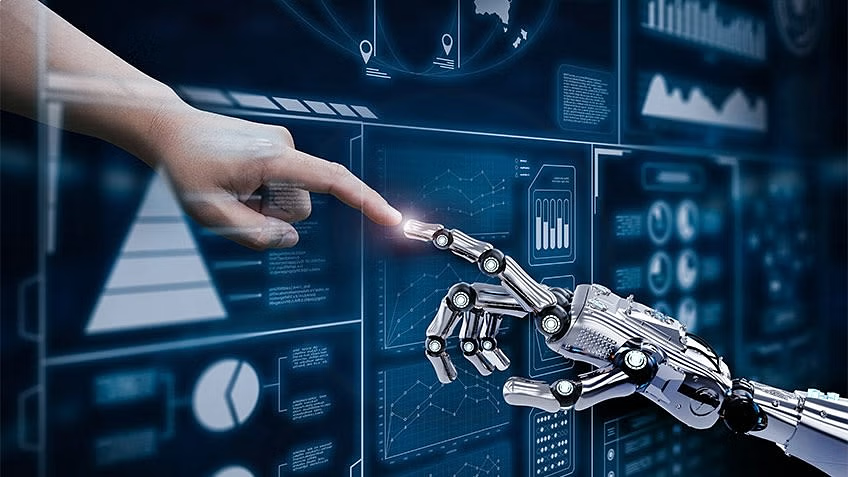Did you know that companies using machine learning are seeing dramatic improvements in performance and customer satisfaction? From predicting trends to automating tasks, machine learning is helping firms work smarter, faster, and better. As more industries adopt this technology, understanding its potential isn’t just optional — it’s essential.
Whether you’re a business owner, a student, or simply curious about how machines are getting “smarter,” this guide is for you. We’ll break down the basics of machine learning in a clear and easy-to-understand way — no technical jargon, just real insights.
Plus, if you’re looking to enhance your productivity using AI, don’t miss our related guide:
👉Best AI Tools to Skyrocket Your Productivity in 2025
Machine learning is changing how companies work. It’s a thrilling time for new ideas. This article will cover the basics of machine learning and its big impact in different fields.
Key Takeaways
- Understanding the basics of machine learning and its applications
- Exploring the potential of machine learning in various industries
- Learning how to harness the power of machine learning for business growth
- Discovering the latest trends and advancements in machine learning
- Understanding the importance of machine learning in today’s business landscape
Understanding the Fundamentals of Machine Learning
Machine learning lets machines learn from data. This has changed how we solve complex problems. It makes solutions more efficient and accurate.
What Is Machine Learning and How Does It Work?
Machine learning is part of artificial intelligence. It trains algorithms to predict or decide based on data. This way, machines get better over time without needing to be told how.
The Core Concept of Algorithms That Learn
The heart of machine learning is its algorithms. These algorithms learn from data. They find patterns, predict, and get better with time through training.
Data-Driven Decision Making
Data-driven decision making is key in machine learning. Machine learning algorithms analyze big data. They spot trends and make smart choices, needing less human help.
The Relationship Between Machine Learning and Artificial Intelligence
Machine learning is closely tied to artificial intelligence. It’s a big part of AI. AI is about machines doing tasks that need human smarts. Machine learning is how machines learn from data and get better.
The Evolution of Machine Learning
Machine learning shows how smart humans can be. It has reached big milestones and made new discoveries. This field has grown from a small research area to a big tech force in many fields.
Historical Development and Key Milestones
The story of machine learning started in the 1950s with the first neural networks. It grew a lot in the next years with new algorithms like decision trees and support vector machines. A big step was the backpropagation algorithm, which helped train complex neural networks.
Recent Breakthroughs Shaping the Field
Machine learning has grown fast in recent years. This is thanks to deep learning and big data. Also, computers can do more now than before.
From Statistical Methods to Deep Learning
Now, machine learning uses deep learning more than old methods. Deep learning models like CNNs and RNNs are very good at recognizing images and speech.
The Impact of Increased Computing Power
Computers are now much faster, thanks to GPUs. This helps train big models on lots of data. It has led to big wins in areas like understanding language and seeing pictures.
| Milestone | Description | Year |
|---|---|---|
| First Neural Networks | Development of the first artificial neural networks | 1950s |
| Backpropagation Algorithm | Introduction of the backpropagation algorithm for training multi-layer neural networks | 1980s |
Core Types of Machine Learning Algorithms
It’s important to know the different machine learning algorithms. They help systems learn from data and make smart choices.
Supervised Learning: Training with Labeled Data
Supervised learning uses labeled data to train a model. The right answer is already known. It’s key for predicting outcomes from input data.
Classification and Regression Techniques
In supervised learning, classification and regression are key. Classification sorts data into groups. Regression predicts continuous values. For example, logistic regression works for yes or no questions. Decision trees can do both.
Real-World Applications
Supervised learning is used in many ways. It’s in image recognition, spam detection, and predictive maintenance. In healthcare, it helps diagnose diseases from images.
Unsupervised Learning: Finding Hidden Patterns
Unsupervised learning works with data without labels. It finds patterns or groups. It’s useful when the data’s structure is unknown.
Clustering and Association Methods
Unsupervised learning includes clustering and association. Clustering groups similar data. Association finds rules in the data. k-means clustering and Apriori algorithm are examples.
When to Use Unsupervised Approaches
Unsupervised learning is great for customer segmentation, anomaly detection, and market basket analysis. It uncovers data structure without preconceptions.
Reinforcement Learning: Learning Through Interaction
Reinforcement learning lets an agent learn by interacting with its environment. It gets rewards or penalties for its actions. This is good for game playing, robotics, and autonomous vehicles.
Essential Technologies Powering Machine Learning
Knowing the main technologies behind machine learning is key. It lets us use its power fully. Several important technologies work together to make machine learning work.
Neural Networks and Deep Learning Architectures
Neural networks are at the heart of machine learning. They are like the human brain. They have layers of nodes or “neurons” that handle and send information.
How Neural Networks Mimic Human Brain Function
Neural networks copy the human brain. They use layers of artificial neurons to spot patterns in data. This happens through complex algorithms that tweak connections between neurons.
Deep Learning Frameworks and Tools
Frameworks like TensorFlow and PyTorch help build and train neural networks. They offer pre-made functions and libraries to make development easier.
Natural Language Processing Capabilities
Natural Language Processing (NLP) lets machines understand human language. It mixes machine learning with language models to analyze and create text.
Computer Vision and Image Recognition
Computer vision is vital in machine learning. It lets machines see and understand visual info. It’s used for things like recognizing images, detecting objects, and facial recognition.
These technologies are changing how machines interact with and get to know the world. They make things possible that we couldn’t dream of before.
Machine Learning Applications Transforming Industries
Machine learning is changing how industries work. It makes things more efficient and productive. It’s used in healthcare, finance, retail, and manufacturing to solve big problems.
If you’re interested in how machine learning and other innovations are reshaping the world — from technology and business to lifestyle and productivity — check out Ablogz, your go-to destination for insightful, easy-to-digest content across multiple domains.
Healthcare: Diagnosis, Treatment, and Drug Discovery
Machine learning is helping healthcare a lot. It makes diagnoses better, treatment plans more personal, and drug discovery faster. It’s used in many ways in healthcare.
Predictive Diagnostics and Personalized Medicine
Machine learning helps find health problems early. This means doctors can treat patients sooner and in a way that fits each person. It’s all about making treatment plans just right for you.
Medical Imaging Analysis
Machine learning looks at medical images like X-rays and MRIs. It helps doctors spot problems faster and more accurately. This makes diagnosis better and helps patients get better sooner.
Finance: Risk Assessment and Fraud Detection
In finance, machine learning helps spot risks and fraud. It looks at lots of data to find patterns that show fraud. This helps banks and other financial places stay safe.
| Industry | Machine Learning Application | Benefits |
|---|---|---|
| Healthcare | Predictive diagnostics, medical imaging analysis | Improved diagnosis accuracy, personalized treatment |
| Finance | Risk assessment, fraud detection | Reduced financial losses, enhanced security |
| Retail | Personalization, inventory management | Increased customer satisfaction, optimized inventory |
| Manufacturing | Predictive maintenance, quality control | Reduced downtime, improved product quality |
Retail: Personalization and Inventory Management
Machine learning changes retail by making shopping better and managing stock better. It helps stores know what customers like and need. This makes shopping more fun and personal.
Manufacturing: Predictive Maintenance and Quality Control
In manufacturing, machine learning helps with keeping things running smoothly. It looks at data from machines to know when they need fixing. This cuts down on downtime and makes things work better.
As machine learning gets better, it will help more industries. This will lead to even more new ideas and changes.
Implementing Machine Learning in Your Organization
To use machine learning, first check if your organization is ready. Look for chances to use it. This step is key to adding machine learning to what you already do.
Assessing Readiness and Identifying Opportunities
Before starting, check your data setup and find problems machine learning can fix.
Data Infrastructure Requirements
A strong data setup is vital for machine learning. You need good data and the right tools to work with it.
Business Problem Identification
Finding the right problems for machine learning is important. Look for areas where it can help a lot, like making things better or improving customer service.
Building the Right Team and Infrastructure
After checking readiness, build a team for machine learning. They need the right skills and tools.
Roles and Skills Needed
A good team has data scientists, engineers, and analysts. Each one is key to making and using machine learning models.
Build vs. Buy Decisions
Decide if you’ll make your own machine learning tools or use existing ones. This choice depends on your budget, setup, and if you need special features.
| Consideration | Build | Buy |
|---|---|---|
| Cost | High upfront costs | Lower initial investment |
| Customization | Highly customizable | Limited customization options |
| Time to Market | Longer development time | Faster deployment |
Starting Small: Pilot Projects and Scaling Up
Start with small projects to test and improve before growing. This way, you can manage risks and show the value of machine learning.

Overcoming Common Challenges in Machine Learning Projects
Starting machine learning projects can face many hurdles. These include data quality problems and picking the right model. As more groups use deep learning and neural networks, knowing these challenges is key to success.
Data Quality and Quantity Issues
One big challenge is dealing with data quality and quantity. Good data is vital for training strong models.
Dealing with Incomplete or Biased Data
Bad data can hurt model performance. Using data imputation and bias detection can help. For example, mean or median imputation for missing values works well.
Data Preparation Best Practices
Good data prep is essential for solving data quality problems. It includes normalizing data, scaling features, and removing extra data. Data normalization makes sure all data is on the same scale, helping models train better.
| Data Preparation Technique | Description | Benefit |
|---|---|---|
| Data Normalization | Scaling numeric data to a common range | Improves model training efficiency |
| Feature Scaling | Standardizing feature values | Enhances model performance |
| Removing Redundant Features | Eliminating unnecessary data | Reduces overfitting risk |
Model Selection and Tuning Difficulties
Finding the right model and tuning it is hard. It means knowing the good and bad of different neural network types. Then, picking the best one for the job.
Ethical Considerations and Bias Mitigation
Machine learning projects must think about ethics, like avoiding bias. Making sure models are fair and clear is very important. Tools like fairness metrics and bias detection help spot and fix bias.
By tackling these challenges, groups can better use machine learning. They can unlock the power of deep learning and neural networks for innovation and success.
The Future of Machine Learning: Emerging Trends and Possibilities
Machine learning is growing fast, with new trends coming up. These changes will make machine learning models better. They will work better in supervised learning and unsupervised learning tasks.

Automated Machine Learning (AutoML)
Automated Machine Learning, or AutoML, is a big deal. It makes using machine learning easier. AutoML handles things like choosing models and adjusting settings.
This makes it simpler for companies to use machine learning. They don’t need to be experts. This could make machine learning more popular in many fields.
Edge Computing and IoT Integration
Machine learning is getting better with Edge Computing and IoT. Edge Computing makes decisions faster by processing data locally. This is great for IoT devices.
They can use machine learning right away. They don’t need to wait for the cloud.
Quantum Machine Learning
Quantum Machine Learning is a new mix of quantum computing and machine learning. It could make machine learning faster and solve hard problems. It’s still new, but it could change how we analyze data.
The future of machine learning is exciting. It’s not just about new tech. It’s also about how we use these trends in our work. Companies will need to figure out how to use these trends to stay ahead.
Conclusion: Embracing the Machine Learning Revolution
Machine learning is changing the world. It’s making big changes in many areas like healthcare and finance. It’s also changing how we shop and make things.
There are different types of machine learning. These include supervised, unsupervised, and reinforcement learning. Natural language processing lets machines talk like us. This makes them very useful.
The future of machine learning looks very promising. New things like Automated Machine Learning (AutoML) and Edge Computing will help it grow. We’ll see more smart machines in the future.
Businesses need to keep up with this change. They must invest in the right tools and people. They also need to work on making sure the data is good and fair. This way, they can use machine learning to grow and succeed.
FAQ
What is the difference between machine learning and artificial intelligence?
Machine learning is a part of artificial intelligence. It trains algorithms to learn from data. This helps them make predictions or decisions.Artificial intelligence is a bigger field. It includes machine learning and other techniques. These help machines do tasks that need human intelligence.
How does deep learning differ from traditional machine learning?
Deep learning uses neural networks to learn from data. It’s good at tasks like image and speech recognition.Traditional machine learning uses simpler models. It often needs feature engineering.
What is the role of natural language processing in machine learning?
Natural language processing (NLP) is a key part of machine learning. It lets computers understand and generate human language.NLP is used in many tasks. These include sentiment analysis, text classification, language translation, and chatbots.
Can machine learning be used with small datasets?
Yes, machine learning can work with small datasets. Techniques like data augmentation and transfer learning help.But, the quality and relevance of the data matter more than how much there is.
How do I choose the right machine learning algorithm for my problem?
Choosing an algorithm depends on your problem, data, and evaluation metrics. Consider the need for interpretability and the data’s complexity.Also, think about the resources you have available.
What is the difference between supervised and unsupervised learning?
Supervised learning uses labeled data. The correct output is known.Unsupervised learning uses unlabeled data. It aims to find patterns or structure.
How can I ensure that my machine learning model is fair and unbiased?
To ensure fairness, consider your data and model performance. Use techniques like data preprocessing and regularization.Fairness metrics can also help identify and reduce bias.
What is the role of predictive analytics in machine learning?
Predictive analytics uses historical data to predict future events. It’s used in finance, healthcare, marketing, and customer service.



























